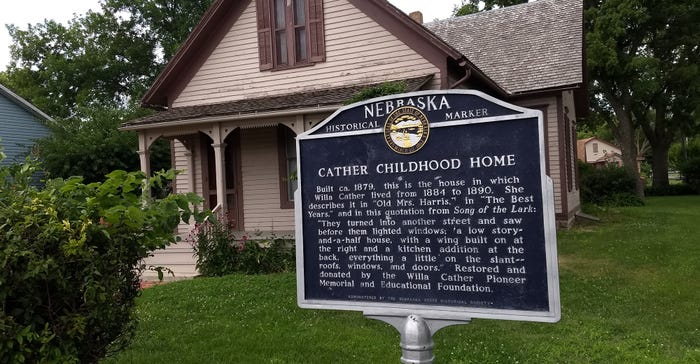
“As I looked about me, I felt that the grass was the country, as the water is the sea,” wrote Willa Cather in her 1918 novel, “My Antonia,” considered by many as her first masterpiece. In this line, Cather wrote about what she knew quite well — the Nebraska prairie.
Born in Virginia in 1873, Cather was 9 years old when her family moved to Webster County, Neb., in part to escape the tuberculosis outbreaks in Virginia, and in part to try farming. The family would later resettle in Red Cloud where Willa’s father opened a real estate and insurance business.
This is where Willa lived out her formative years until she attended college at the University of Nebraska-Lincoln, starting in 1890. Her first writing works were printed in the local newspaper, the Red Cloud Chief.
At UNL, Cather, who won the Pulitzer Prize in 1923 for “One of Ours” set during World War I, studied mathematics taught by John J. Pershing, the future General of the Armies during World War I — and a Pulitzer Prize winner himself in 1932.
After college, Cather worked as a journalist and high school teacher. She was managing editor of McClure’s magazine in 1906 and moved to New York City. Her first novel, “Alexander’s Bridge,” was published in 1912.
After that, she published three novels in rapid succession, including “O Pioneers!” in 1913; “The Song of the Lark” in 1915; and “My Antonia” in 1918, with all three set on the Great Plains. “One of Ours” was published in 1922, followed by “A Lost Lady” the next year.
Her last trip back to Red Cloud came in 1931 after her mother passed away. Yet, the community influenced Cather in her writings throughout her life, and she stayed in close touch with many friends in Nebraska.
She finished her last novel, “Sapphira and the Slave Girl,” in 1940. Diagnosed with breast cancer in 1945, Cather had a mastectomy in early 1946. But the cancer had metastasized to her liver. She died in April 1947 of a cerebral hemorrhage, and she is buried at the Old Burying Grounds in Jaffrey, N.H. Her last short fiction work, “Old Beauty and Others,” came out in 1948.
If you stroll downtown in Red Cloud today, Cather’s spirit is everywhere. Starting at the National Willa Cather Center along Webster Street, you can enjoy numerous exhibits about Cather’s early life in Red Cloud, as well as her long professional writing career.
From the center, you can sign up for a guided historic site tour that takes you to the Cather sites, including her childhood home, the Burlington Depot, Red Cloud Opera House and Farmers and Merchants Bank. You can stay overnight at the Cather Second Home, now a six-bedroom guesthouse that is also available for family retreats, meetings and special occasions.
Be sure to drive 5 miles south of town to visit the Willa Cather Memorial Prairie, located just along the Kansas border on 612 acres of unbroken prairie, where you can hike and enjoy the prairie views, plants and wildlife.
Cather herself may have lived in the East during most of her professional writing career, but in many ways, she never left Red Cloud. She writes about the prairie and the people with such detail and insightfulness, because they were so familiar to her in those early days of her distinguished life.
Learn more online at WillaCather.org.
About the Author(s)
You May Also Like






